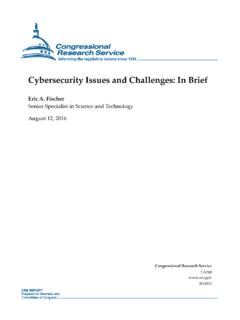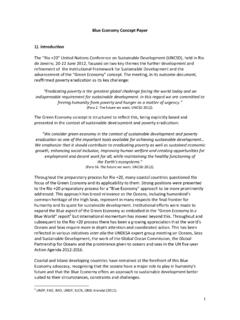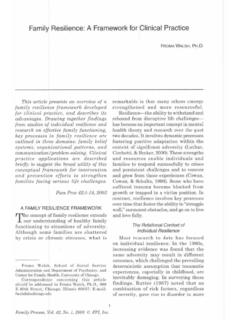Transcription of The Marine Corps Operating Concept
1 The Marine Corps Operating Concept How an Expeditionary Force Operates in the 21st Century The Marine Corps Operating Concept (MOC) describes, in broad terms, how Marine Corps forces will conduct the range of military operations in accordance with our Title 10 responsibilities. The MOC provides the foundation and context for subordinate Operating and functional concepts, guides analysis, wargaming and experimentation and informs capability development and budget programming decisions. Concepts in their simplest forms are ideas that are matured and refined through exploration, debate and discussion. The Marine Corps Operating Concept How an Expeditionary Force Operates in the 21st Century i DEPARTMENT OF THE NAVY HEADQUARTERS UNITED STATES Marine Corps WASHINGTON, 20380-1775 September 2016 FOREWORD As a warfighting organization, we must recognize the challenges of the future and develop an operational approach to fight and win.
2 The MOC embraces our naval character, expeditionary mindset, and professional approach to constantly improve and build on our foundations of maneuver warfare and fighting as a combined arms force. The challenges of the future will impact how we organize our Corps and ultimately fight our Nation s battles. The MOC describes the steps we will take to design, develop, and field a future force for the 21st century. The success of this Concept depends on our Marines and Sailors. Our people have always been the Marine Corps center of gravity and the key to our success as warfighters. Their ability to think critically, innovate smartly, and adapt to complex environments and adaptive enemies has always been the key factor we rely on to win in any clime and place. The profession of arms is unforgiving; mistakes are paid for in blood and incompetence can lead to catastrophic defeat.
3 When we fight, we must win. There is no alternative. The American people expect and deserve nothing less from their Marine Corps . Our preparation for the inevitable conflicts of the future begins with this Operating Concept . It charts how we will transform ourselves to deter and defeat the threats of tomorrow. Yet the MOC also acknowledges the timeless, violent nature of war and reaffirms our primary purpose. The Marine Corps exists to defeat our Nation s enemies. Even in a world of ever-increasing technology, we must continue to provide combat formations capable of closing with and destroying the enemy. This imperative drives us to demand physical toughness and resilience in our Marines and Sailors, and expect their brilliance in the fundamentals of warfighting.
4 While the means and methods we use to wage war will evolve, we must always be prepared for the violence of combat. The MOC does not provide an answer to every problem. Rather, it is intended to generate professional debate and discussion about our future challenges. We need every Marine and Sailor to seek creative solutions to today s and tomorrow s complex problems. We need your ideas and your critical thinking. We need to change where it makes sense, adapt as quickly as possible, and constantly innovate to stay ahead of our adversaries. Our ability to adapt more quickly than our enemies will be vital to our future success. We need all Marines to read, discuss, and challenge the ideas in the MOC. As steel sharpens steel, your review and professional recommendations will sharpen our Concept of how we will fight in the future.
5 Your proactive involvement in validating our Operating Concept is critical to ensuring we can Innovate, Adapt, and Win! The Marine Corps Operating Concept How an Expeditionary Force Operates in the 21st Century ii Table of Contents 1. Looking Ahead How We Will Operate and Fight in 2025 .. 1 2. Purpose and Context .. 4 3. The Future Security Environment: Key Drivers of Change .. 5 4. Statement of the Central Problem .. 8 5. Our Operating Concept : Maneuver Warfare in Every Dimension; Combined Arms in All Domains .. 8 Executing the Concept .. 9 Pursuing Change: Priorities and Risk .. 10 6. Creating the Future Force: Critical Tasks and Issue Areas .. 10 Critical Task: Integrate the Naval Force to Fight At and From the Sea .. 10 Critical Task: Evolve the 13 Critical Task: Operate with Resilience in a Contested-Network Environment.
6 17 Critical Task: Enhance Our Ability to Maneuver .. 19 Critical Task: Exploit the Competence of the Individual 24 7. Conclusion .. 27 The Marine Corps Operating Concept How an Expeditionary Force Operates in the 21st Century 1 1. Looking Ahead How We Will Operate and Fight in 2025 1 May 2026 Warner Center for Advanced Military Studies, MCB Quantico. Good afternoon and welcome to the last warfighting session of Command and Staff Class 2026. Over the last week, we ve formally studied OLR Operation Littoral Resolve the largest integrated Naval force operation since Inchon. As you know, in OLR we deployed a MEF a Marine Expeditionary Force as part of a Combined/Joint force to assist one of our key allies in repelling an aggressive neighbor and quelling a proxy-force insurgency.
7 Today we re going to hear from veterans of that operation and have a frank, Marine -to- Marine discussion of lessons learned. Let s get started. Moderator: Capt Pierce, you were a company commander on the MEU. How did OLR start for you? Well, up to the point that the enemy started crossing the border, we were on the ground training the locals. Teaching them basic tactics, but also gathering current info on the culture, politics and situation, who s doing what to whom, and doing some messaging so that if we had to come back, the populace would understand why. When things started deteriorating, we were pulled back to the ships and re-tasked to set up an EAB an Expeditionary Advanced Base on an island at the fringes of the enemy keep-out zone. The idea was to establish a sensor line to get a better read on enemy signatures and movements.
8 It helped that the island had a decent patch of paved road to use to arm and refuel aircraft. So, it was a good target, but now we had to take it. With the new moon and zero illum, we came in fast from long range on small boats. Worst beaches you ve ever seen. Windward side, rocks everywhere, shoving boats in between the breakers. Really high-risk in the dark probably impossible without recon and unmanned systems confirming the landing sites. Fortunately, recon swimmers were there to greet us. We infiltrated by platoon towards the objective area. GPS access wasn t so hot, but we had maps and compasses and knew how to get where we were going. Our unit humped through some really rough ground to the assault position. In a few hours, we were right on top of the enemy and they didn t have a clue.
9 Working from our F-35 feeds, we sent up our UAS killers to take out their crew-served positions and command posts. The mortar section got fire capped and was able to drop precision rounds right where the squad leaders told us to put em. They tapped the app and had rounds on target. The fight lasted about 45 minutes before we had things under control and the EAB was ready to take the first aircraft. Moderator: LtCol Winchester, you commanded one of the BLTs during the amphibious assault. How did you put that force ashore, particularly given the enemy s capabilities? Our battalion was one of two that went in vertically. Two others came in via surface. Units coming across the beach had to worry about mines and hasty obstacles, which they had a good set of unmanned capabilities to help them breach, and massed fires, which could have been catastrophic.
10 While the landing force didn t get ashore unscathed, they mitigated the damage by using numerous small landing sites and emphasizing speed and dispersion. For our force, the key was ensuring that we could get in without being shot to pieces by the IADS. We were supporting and supported by MARSOC/SOF raids to give us secure movement corridors. We went into multiple LZs vice a single big one, inserting a good ways away from the actual objectives to disguise our intent and present a tougher targeting problem for massed enemy fires. To deal with the extra distance and additional weight from our organic precision fires from our 120s we utilized a mix of ultralight vehicles and robotic cargo systems. During the actual vertical assault, information coming in from manned recon elements, unmanned ground sensors and overhead ISR feeds let me understand the state of the LZs and gave me near real-time targeting data.







